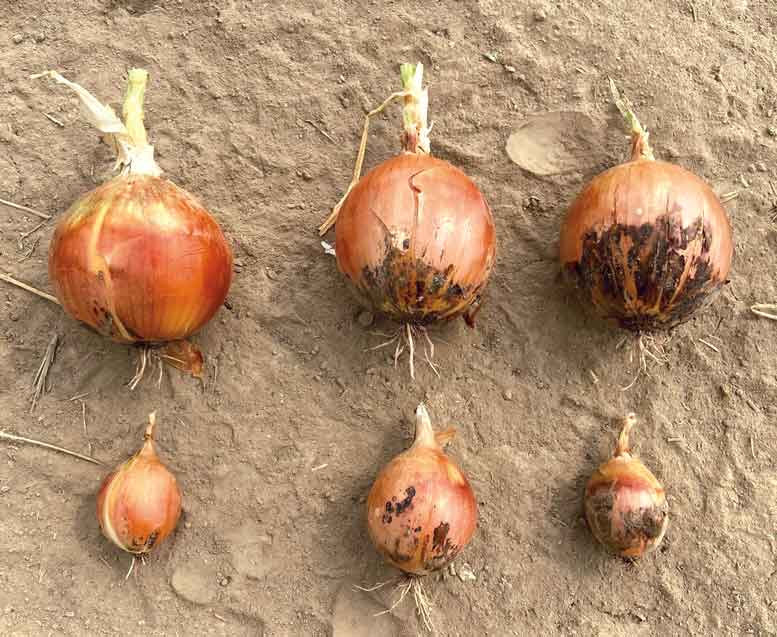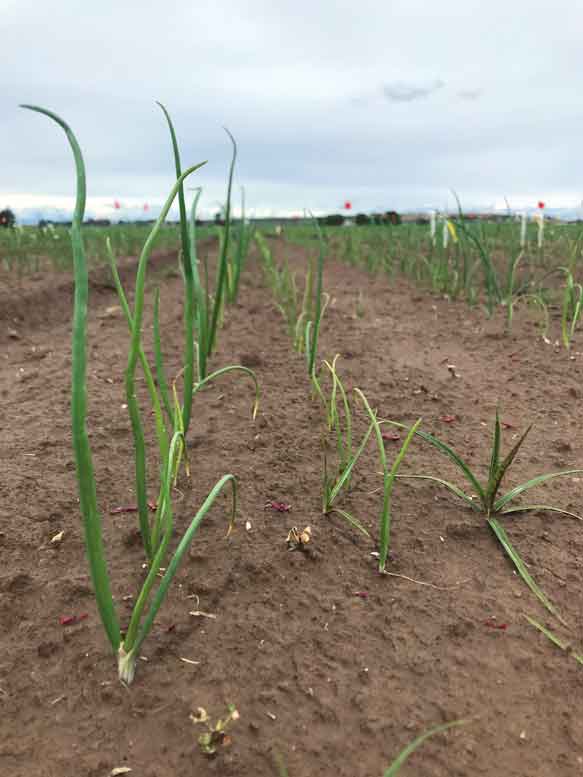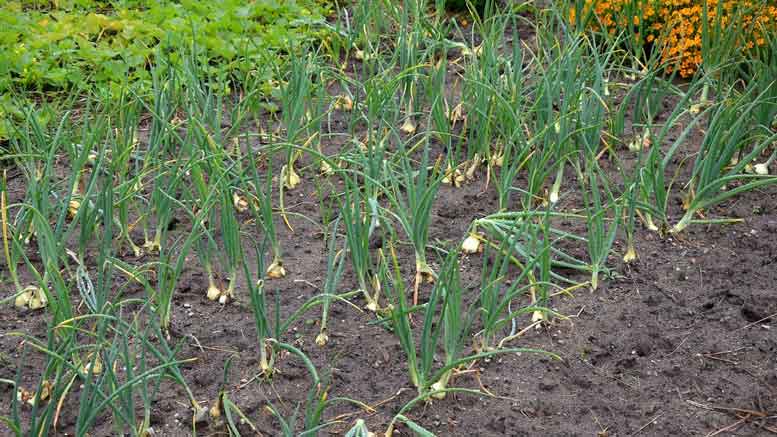|
Click to listen to this article
|
By Denise Keller, Editor
Do onions in the inside rows of a planting bed get the short end of the stick? Researchers in Idaho asked the question and say “yes.”
Mike Thornton, a professor of plant science at the University of Idaho, has been studying differences in stand, yield and bulb size based on plants’ distance from irrigation drip tape.
Putting Numbers to the Observations
The work started after Idaho onion growers observed in 2019 that onions planted near drip line weren’t growing as well as onions planted farther from the tape. Researchers paid attention the following year and saw that, sure enough, onions closer to the drip tape were significantly stunted compared to the outer row.
To determine whether the stunting observed was substantial enough to impact onion growers’ bottom line, University of Idaho researchers began a study in 2021. Working with a 44-inch bed, they planted a double row of onions on each side of irrigation drip tape, with the inside rows 6 inches from the tape and the outside rows 9 inches from the tape.
Two months after planting, the inside rows had a plant stand of 75 percent compared to 81 percent in the outside rows. Some plants were lost throughout the season, regardless of placement within the bed; however, at the end of the season, inside rows had about 9,000 fewer plants per acre than the outside rows. In addition, yield was 200 cwt per acre lower and bulbs were 2.4 ounces smaller, on average.
Thornton’s team repeated the trial in 2022 with similar results: 11 percent difference in initial stand, 4,000 fewer plants per acre at the end of the season and 70 sacks per acre less yield. The difference in bulb size was less significant. In 2023, the inside rows yielded 120 fewer sacks per acre.
“Think about that going back to stands. Usually when we have a thin stand, those onions blow up, they get big, they get bull necks. Here, we have less stand, yet the onions are smaller. So it’s not just the fact that we’re losing stand; the onions just aren’t growing as vigorously all season long for some reason and they’re staying small when we would expect that they would actually be bigger,” Thornton said. “I think that’s important enough to pay attention to. If I told you I could help you get 100 sacks more in yield or 5 tons more per acre, most people would say, ‘yeah, I’ll sign up for that.’”

Identifying the Root Causes
During 2021 and 2022, the researchers identified several differences in soil conditions in the inner rows compared to the outer rows that could explain the reduced stand, yield and bulb size. The inner row next to the tape experienced wetter and slightly colder soil conditions than the outer row. The inner row also had less soil compaction – and thus, poorer seed-soil contact, which is important for germination, Thornton said.
“When we go through and put beds down in the spring, most of that soft soil is ending up in the middle, and then we’re shanking the drip tape in, which is breaking up the soil and making it less compact, too. It’s great for not having compaction, but it’s maybe not great for seed-soil contact. So that could explain why we’re having variable germination early in the season,” Thornton said.
The researchers also found that the incidence of pink root was 22 percent higher in the rows closer to the drip tape, and severity was 3 percent higher. Researchers believe that the wetter, cooler soil closer to the drip tape creates an environment more conducive to disease development, resulting in the lower yields and bulb size observed in the inner row.

Taking a Closer Look
In 2023, researchers began evaluating ways to modify the soil conditions in the rows closer to the drip tape. To provide more uniform moisture across the planting bed, researchers evaluated drip tape emitter volume. They also applied pelleted bio-char over the seed row at planting to absorb sunlight and warm the inner rows and even out temperature fluctuations. To address soil compaction, they used a press wheel behind the planter to firm the soil and provide more uniform seed-soil contact.
Finally, the research team examined the role of pink root by planting into a section of the field fumigated with chloropicrin and comparing it to non-fumigated ground in order to determine if the extent of stunting, stand loss, yield and bulb size reduction is related to the level of root disease.
The increases in pink root, reduction in total yield and smaller bulb size for onions closest to the drip tape found in 2023 closely matched what researchers observed in 2021 and 2022. And while the soil warming and soil firming treatments did change the temperature and firmness of the soil around the seed during emergence and early plant growth, they failed to provide any improvement in stunting and yield loss for onions in the inner row. From these results, it does not seem likely that soil temperature and firmness are the main cause of the stunting observed, according to Thornton.

Likewise, fumigation reduced pink root levels but did not reduce the difference in yield or bulb size between the inner and outer rows, indicating that pink root is probably not one of the main factors driving the stunting and reduced yields in inner rows.
However, the researchers are interested in taking a closer look at the role of the drip tape emitter volume. In the 2023 trial, they increased tape flow from 0.25 gpm/100ft to 0.34 gpm/100ft to allow for faster movement of the wetting front. This treatment tended to produce the highest bulb yields and minimize the difference between inner and outer row locations. Thornton recommends that this high-flow drip tape treatment be evaluated for at least one additional year to confirm the results.

